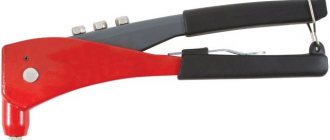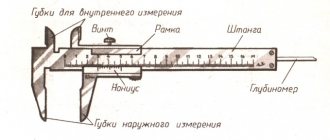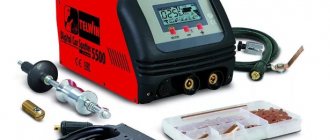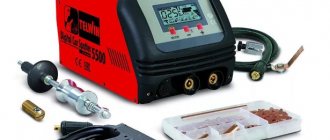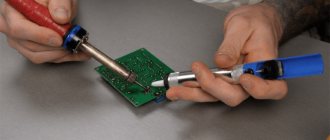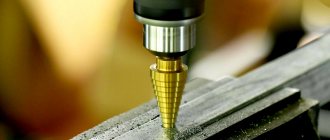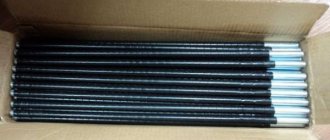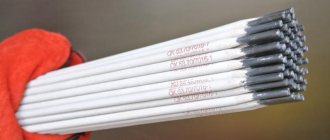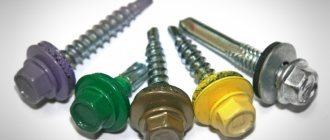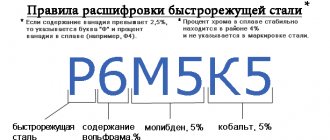Forging chisel PICARD. Photo ForgingPRO
A chisel (a cleaver with a handle) is one of the oldest tools for processing cold or hot metal . Scientific and technological progress has made very minor improvements to this tool, offering high-strength materials for use and formalizing the sharpening angles of the blade. However, the appearance and methods of working with a chisel have not changed for many centuries. This article provides complete information about blacksmith tools for chopping metal, types, the possibility of making it yourself or purchasing a factory-made cleaver.
Bench chisels
The blade and head of a bench chisel are hardened and tempered . The length is usually 10-20 cm, and the width of the blade is 5-5.2 mm. The sharpening angle of the blade depends on the metal for which this chisel will be used - the harder or more brittle the metal, the more obtuse the sharpening angle should be. Standard sharpening angles for cutting various metals are as follows:
- hard steel, bronze, cast iron – 70 degrees;
- medium hard steel – 60 degrees;
- copper, brass – 45 degrees;
- zinc, aluminum alloys – 35 degrees.
The tool is also widely used for more specialized tasks, such as cutting grooves and narrow grooves. This instrument is called a crossmeisel .
Blacksmith chisels
The main design difference between a blacksmith's chisel and a mechanic's chisel is the hole in its middle part for mounting on a wooden handle. The cutting part of a forging chisel is called a knife, its length is from 30 to 50 mm. The length of the entire tool for cutting cold metal is 16-19 cm, for cutting hot metal – 18-24 cm.
Cold cutting forge chisel
Device and characteristics
A common metalworking chisel is represented by a steel rod, one side of which is sharpened on both sides. In order to be able to strike the instrument, there is a flat butt. It is worth considering that tools such as a metalworking chisel are divided into two main categories: for manual work and for installation in a power tool.
Today, metalworking chisels are produced in accordance with GOST, which determines the main qualities. The shape of the rod is often rectangular with non-essential edges that are rounded. In addition, there are oval, round and some other sections. The main characteristics are the following:
- Application area.
- Type of tool.
- Purpose.
- Length and width of the working part.
- Material used in manufacturing.
- Design.
- In case of cross-sectional diameter, it has a cylindrical shape.
- Weight.
Download GOST 7211-86
The bench chisel consists of the following parts:
- blades;
- working part;
- middle part;
- impact part (head).
The common 1991 machinist's chisel may also have a mushroom-shaped tip, which in most cases is made of rubber. This makes it much easier to strike.
What types are there: intrinsically safe with a wooden handle and others, photo
There are several types of blacksmith chisels:
- Non-sparking tools are designed for use in potentially explosive areas. The head of such chisels is made of bronze alloys, which ensures antimagnetic properties and a high level of corrosion resistance, and the handle is made of wood.
Blacksmith chisel. Photo ForgingPRO
- Chisels with a thin blade are designed for chopping hot metal, while those with a thicker blade are designed for separating cold workpieces.
- The shape of the working part can be straight or round.
Chisel. Types and work. Application and sharpening. Peculiarities
A chisel is a percussion-cutting tool designed for chopping or chipping metal and stone. It is a steel rod with double-sided sharpening and a flat butt designed for striking with a hammer. The design of the chisel can position it as a hand tool or as an attachment for mounting in a hammer drill. The cross-section of the rod can be in the shape of a circle, rectangle, oval or polyhedron. To reduce the risk of injury, an expanding mushroom made of rubber or other metal can be installed on the striking part of the tool, providing a more comfortable hammer hit and dampening recoil.
Scope of application
The tool is designed for mechanical impact with destructive force. The scope of its use is quite extensive, but in most cases it is limited to:
- By chipping stones.
- Metal chopping.
- Knocking down ceramic tiles.
- By beating off the rivet heads.
- Unscrewing bolts and nuts with torn edges.
To work, you need to lean the sharp part of the chisel against the surface that needs to be knocked off, chipped or cut, and then apply a strong blow to the butt of the tool with a hammer. If it is necessary to unscrew a bolt or nut with torn edges, then the sharp edge is leaned at an angle, after which several light taps are applied to obtain a notch. After a groove is formed on the surface of the metal, several powerful blows are made to the butt of the chisel. In this case, the direction of the push force must correspond to the movement of the thread for unwinding. After using a chisel, the nut or bolt becomes completely unusable.
Types of chisels and their purpose
Despite the fact that the tool has a simple design, there are several varieties designed to perform specific tasks.
The following types of chisels exist:
- Metalworking.
- Kreuzmeisel.
- Ditcher.
- Pike.
- Kuznechnoye.
- Boaster.
The bench chisel is designed for cutting unhardened metals. It is quite sharp and can be used both for marking sheet material and for unscrewing bolted joints, knocking down rivets and other impromptu tasks. The cutting tip of the tool is slightly wider than the rod. The two-sided slopes gradually taper. Sometimes you can find a microchamfer on a chisel.
The Kreutzmeisel is a fairly recognizable tool with a narrowed cutting edge, which allows cutting out grooves and various grooves. Such a tool is more highly specialized than a metalworking tool, and therefore is not found as often. However, they can be completely used when knocking down ceramic tiles or rivet heads if there is no more suitable tool at hand.
A groover is an even more narrowly targeted tool designed for cutting out shaped channels. It is usually used when it is necessary to manually cut cylinder head gaskets from rigid sheet material, as well as other specific tasks when it is impossible to get by with another tool. The shape of the cutting edge can be wavy, semicircular, oval and U-shaped.
The pike is almost an ordinary chisel, the tail part of which is narrowed. In its design, instead of a striking cap, the rod is ground to a smaller diameter, which allows it to be fastened into the clamping chuck of a hammer drill. The shape of the cutting edge can be point, narrow or wide, like a chisel.
A forging chisel can have a wide variety of cutting part shapes. Its main difference is the presence of a special groove in the tail section for the possibility of attachment to a wooden or metal handle. When assembled, it looks a bit like a sharp hammer. The tool is used for chopping or punching holes in red-hot metal. The presence of an elongated side handle allows you to protect the blacksmith’s hands from heat and flying sparks. There are also tools whose handles are welded using electric welding.
A scarpel is a sharper tool designed for working with stone. Often its working part resembles a spatula. The tool is designed for smooth processing of stone and in most cases is used by sculptors. Typically, a wide rubber mushroom is provided in the striking part of the tool, which is not only designed to protect the hand holding the rod, but also to block the scattering of small pebbles.
How to distinguish a chisel for metal from a tool for stone
Individual designs of tools for different purposes can be very similar, so it can be difficult to figure out which one is intended for metal and which for stone. If the cutting edge is very wide in the shape of a spatula, then this is undoubtedly a tool for working with stone. Tools for metal are always solid cast from one material. It undergoes special hardening, as a result of which the cutting edge is harder than the rod at the shank, which is struck with a hammer. This prevents cracking in case of strong impact. Most stone chisels have carbide tips instead of a cutting edge, which can be easily seen. They provide easier chipping, but are completely unsuitable for metal where chopping is needed.
Tool sharpening
The sharpening angle of the chisel is usually 35, 45, 60 and 70 degrees, depending on its purpose. In most cases, the cutting edge of the tool does not have a microbevel, so it is not razor sharp. To prevent the blade from chipping, it is always slightly dull, but such precaution still cannot completely protect the tool from complete loss of cutting properties. Over time, the cutting edge may deteriorate greatly and will require sharpening. This can be done using sandpaper.
Before starting work, you should prepare a small container with clean water into which you will need to dip the heated tool to prevent softening of its factory hardening. Sharpening of the tool is carried out along the end part of the emery wheel. The chisel blade is set against the direction of rotation of the emery machine. As a result, sparks should go to the floor. Turning the striking part away from you is not allowed. Depending on the power of the emery, as well as the ambient temperature, cooling the tool in water should be carried out at intervals of 30 seconds to 1 minute. If you overexpose the edge, it will heat up excessively and lose its hardness, after which it will not be able to cut hard metals.
When sharpening, it is necessary to periodically change the side of contact of the cutting edges, since the chisel has two-sided slopes. Systematic turning allows you to maintain the correct geometry. If you don’t have sandpaper at your disposal, sharpening can be done on a whetstone. In this case, you will have to devote significantly more time. Movement along the block should also be carried out with the blade forward.
Sharpening chisels, angle
Sharpening is performed on a special sharpening machine. The chisel is placed on the tool rest and, pressing slightly, slowly moved along the entire width of the rotating abrasive wheel, alternately sharpening one or the other edge. In this case, the blade should be often immersed in cold water to prevent overheating of the metal, during which it loses the necessary hardness.
After sharpening is completed on the grinding wheel, the burrs are removed from the chisel, and then the cutting edge is threaded on the abrasive wheel.
Hot forging chisel with a sharpening angle of 70-80 degrees
The sharpening angle of the chisel knife for hot cutting is no more than 50 degrees, and for cold cutting - at least 60 degrees.
Important! The wooden handle on which the forging chisels are mounted is not wedged (to avoid kickback and breakage).
Finally, the correct sharpening angles of the blade are checked with a special template . As such a template, a metal block is used, in which grooves are cut. The angles in these grooves have the required values, therefore, by inserting a sharpened chisel blade into this groove, you can visually determine the correct sharpening.
Excerpt characterizing Chisel
“Eh bien, retournez a l'armee, [Well, then return to the army.],” he said, straightening up to his full height and turning to Michaud with a gentle and majestic gesture, “et dites a nos braves, dites a tous mes bons sujets partout ou vous passerez, que quand je n'aurais plus aucun soldat, je me mettrai moi meme, a la tete de ma chere noblesse, de mes bons paysans et j'userai ainsi jusqu'a la derniere ressource de mon empire. “Il m’en offre encore plus que mes ennemis ne pensent,” said the sovereign, becoming more and more inspired. “Mais si jamais il fut ecrit dans les decrets de la divine providence,” he said, raising his beautiful, gentle and sparkling eyes to the sky, “que ma dinastie dut cesser de rogner sur le trone de mes ancetres, alors, apres avoir epuise tous les moyens qui sont en mon pouvoir, je me laisserai croitre la barbe jusqu'ici (the sovereign pointed with his hand to half his chest), et j'irai manger des pommes de terre avec le dernier de mes paysans plutot, que de signer la honte de ma patrie et de ma chere nation, dont je sais apprecier les sacrifices!.. [Tell our brave men, tell all my subjects, wherever you go, that when I no longer have a single soldier, I myself will stand in the head of my kind nobles and good men and thus deplete the last funds of my state. They are greater than my enemies think... But if it were destined by divine providence that our dynasty should cease to reign on the throne of my ancestors, then, having exhausted all the means in my hands, I will grow a beard until now and would rather go eat one potato with the last of my peasants, rather than dare to sign the shame of my homeland and my dear people, whose sacrifices I know how to appreciate! the depths of his office. After standing there for a few moments, he returned with long steps to Michaud and with a strong gesture squeezed his hand below the elbow. The sovereign’s beautiful, meek face became flushed, and his eyes burned with a gleam of determination and anger. – Colonel Michaud, n'oubliez pas que je vous dis ici; peut etre qu'un jour nous nous le rappellerons avec plaisir... Napoleon ou moi,” said the sovereign, touching his chest. – Nous ne pouvons plus regner ensemble. J'ai appris a le connaitre, il ne me trompera plus... [Colonel Michaud, do not forget what I told you here; maybe someday we will remember this with pleasure... Napoleon or I... We can no longer reign together. I recognize him now, and he will not deceive me anymore...] - And the sovereign, frowning, fell silent. Hearing these words, seeing the expression of firm determination in the eyes of the sovereign, Michaud - quoique etranger, mais Russe de c?ur et d'ame - felt himself at this solemn moment - entousiasme par tout ce qu'il venait d'entendre [although a foreigner, but Russian at heart... admiring all that he heard] (as he spoke afterwards), and he in the following expressions depicted both his feelings and the feelings of the Russian people, whom he considered himself authorized. - Sire! - he said. – Votre Majeste signe dans ce moment la gloire de la nation et le salut de l'Europe! [Sovereign! Your Majesty is signing at this moment the glory of the people and the salvation of Europe!] The Emperor released Michaud with a bow of his head. While Russia was half conquered, and the inhabitants of Moscow fled to distant provinces, and militia after militia rose to defend the fatherland, it involuntarily seems to us, who did not live at that time, that all Russian people, young and old, were busy only with to sacrifice oneself, save the fatherland or cry over its destruction. Stories and descriptions of that time, without exception, speak only of self-sacrifice, love of the fatherland, despair, grief and heroism of the Russians. In reality this was not the case. It seems to us that this is so only because we see from the past one common historical interest of that time and do not see all those personal, human interests that the people of that time had. Meanwhile, in reality, those personal interests of the present are so much more significant than general interests that because of them the general interest is never felt (not even noticeable at all). Most people of that time did not pay any attention to the general course of affairs, but were guided only by the personal interests of the present. And these people were the most useful figures of that time.
Requirements
The main requirement for a blacksmith chisel is its serviceability . Safety of using the tool includes several characteristics that the chisel and its individual parts must have:
- The strikers must have a smooth surface , without chips, cracks, burrs, or deformation.
- The handle, necessarily made of hardwood or synthetic materials, must have an oval shape with a thickening towards the free end and a smooth surface, without cracks. Metal handles are also used, which also do not fit tightly, and rope handles.
- The length of the chisel should not be less than 150 mm.
- When working with a chisel, individual parts of the metal may fly off to the sides, so it is necessary to wear safety glasses.
Chisel rating
When making chisels, manufacturers pay attention not only to performance characteristics, but also to shape, size, and appearance.
Choosing a good tool from a wide range is quite difficult. Below is a rating of the best chisels (according to experts and buyers).
- FIT 46755. Tool steel hand chisel with a hex shank that is virtually impossible to bend.
Rubber handle reduces vibration. The buttplate is equipped with a mushroom guard to prevent shock to the hand.
- TOPEX 03A149 is used for making large recesses.
A strong grip and comfortable use are provided by four wavy ribs on the handle.
The hexagonal rod with stiffening ribs does not deform under loads.
- Stanley FatMax 25x305 mm is used for processing various metals; it fits securely in the hand and does not slip thanks to the shaped rubberized handle with an increased diameter.
The tool is equipped with a durable, bend-resistant hexagonal rod and a protective “fungus”.
The width of the working part is 25mm.
- SDS MAX MATRIX 70343 is a model for a rotary hammer with which you can lay communications.
The tool is resistant to deformation and corrosion, easy to use, and has a long service life.
- MATRIX. The oxidized chisel is protected from corrosion.
The model is made of carbon steel 50 CrMo, the tool is successfully used for cutting various materials.
Malfunctions
Among the most common breakdowns of a forging chisel are:
- break;
- dullness;
- the appearance of notches;
- deformation, curvature of the striker;
- cold hardening on the striker, which is fraught with chips and flying fragments.
Chisel striker broken
Malfunctions arise in the event of incorrect cutting, during prolonged use of the tool, or in the presence of manufacturing defects. Periodically (at least once a quarter) it is necessary to inspect the chisel for any damage to the striker or handle. Faulty tools that have defects must be removed from service.
Tools for hot metal forging
Blacksmith hammer-smoother. Photo ForgingPRO
Each master creates a set of necessary equipment independently, depending on the level of skills and assigned tasks. The blacksmith's kit includes a different list of tools: basic and auxiliary:
- hammer, sledgehammer and anvil;
- pliers (tongs);
- nail shop;
- manual and lining forks;
- vice.
Using the listed tools, various operations for processing metal workpieces are performed: chopping, bending, giving the desired shape through deformation.
Hand tools for artistic forging have a simple design, so they are easy to make with your own hands.
